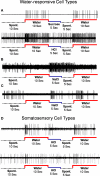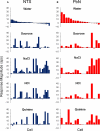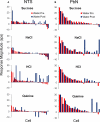Water as an independent taste modality
- PMID: 21048894
- PMCID: PMC2967336
- DOI: 10.3389/fnins.2010.00175
Water as an independent taste modality
Abstract
To qualify as a "basic" taste quality or modality, defined as a group of chemicals that taste alike, three empirical benchmarks have commonly been used. The first is that a candidate group of tastants must have a dedicated transduction mechanism in the peripheral nervous system. The second is that the tastants evoke physiological responses in dedicated afferent taste nerves innervating the oropharyngeal cavity. Last, the taste stimuli evoke activity in central gustatory neurons, some of which may respond only to that group of tastants. Here we argue that water may also be an independent taste modality. This argument is based on the identification of a water dedicated transduction mechanism in the peripheral nervous system, water responsive fibers of the peripheral taste nerves and the observation of water responsive neurons in all gustatory regions within the central nervous system. We have described electrophysiological responses from single neurons in nucleus of the solitary tract (NTS) and parabrachial nucleus of the pons, respectively the first two central relay nuclei in the rodent brainstem, to water presented as a taste stimulus in anesthetized rats. Responses to water were in some cases as robust as responses to other taste qualities and sometimes occurred in the absence of responses to other tastants. Both excitatory and inhibitory responses were observed. Also, the temporal features of the water response resembled those of other taste responses. We argue that water may constitute an independent taste modality that is processed by dedicated neural channels at all levels of the gustatory neuraxis. Water-dedicated neurons in the brainstem may constitute key elements in the regulatory system for fluid in the body, i.e., thirst, and as part of the swallowing reflex circuitry.
Keywords: gustatory; nucleus of the solitary tract; parabrachial nucleus of the pons; taste; water.
Figures





Similar articles
-
Taste responses in neurons in the nucleus of the solitary tract that do and do not project to the parabrachial pons.J Neurophysiol. 1995 Jul;74(1):249-57. doi: 10.1152/jn.1995.74.1.249. J Neurophysiol. 1995. PMID: 7472328
-
Variability in responses and temporal coding of tastants of similar quality in the nucleus of the solitary tract of the rat.J Neurophysiol. 2008 Feb;99(2):644-55. doi: 10.1152/jn.00920.2007. Epub 2007 Oct 3. J Neurophysiol. 2008. PMID: 17913985 Free PMC article.
-
Taste coding of complex naturalistic taste stimuli and traditional taste stimuli in the parabrachial pons of the awake, freely licking rat.J Neurophysiol. 2016 Jul 1;116(1):171-82. doi: 10.1152/jn.01119.2015. Epub 2016 Apr 27. J Neurophysiol. 2016. PMID: 27121585 Free PMC article.
-
Taste responses of cortical neurons.Prog Neurobiol. 1984;23(4):273-315. doi: 10.1016/0301-0082(84)90007-8. Prog Neurobiol. 1984. PMID: 6398454 Review.
-
Excitatory and inhibitory modulation of taste responses in the hamster brainstem.Ann N Y Acad Sci. 1998 Nov 30;855:450-6. doi: 10.1111/j.1749-6632.1998.tb10605.x. Ann N Y Acad Sci. 1998. PMID: 9929638 Review.
Cited by
-
Thirst Increases Chorda Tympani Responses to Sodium Chloride.Chem Senses. 2017 Oct 1;42(8):675-681. doi: 10.1093/chemse/bjx052. Chem Senses. 2017. PMID: 28981824 Free PMC article.
-
c-Fos Expression in the Nucleus of the Solitary Tract in Response to Salt Stimulation in Rats.Korean J Physiol Pharmacol. 2011 Dec;15(6):437-43. doi: 10.4196/kjpp.2011.15.6.437. Epub 2011 Dec 27. Korean J Physiol Pharmacol. 2011. PMID: 22359483 Free PMC article.
-
Exploring brain functional connectivity in patients with taste loss: a pilot study.Eur Arch Otorhinolaryngol. 2023 Oct;280(10):4491-4499. doi: 10.1007/s00405-023-08019-4. Epub 2023 May 17. Eur Arch Otorhinolaryngol. 2023. PMID: 37198301 Free PMC article.
-
Challenges to Body Fluid Homeostasis Differentially Recruit Phasic Dopamine Signaling in a Taste-Selective Manner.J Neurosci. 2018 Aug 1;38(31):6841-6853. doi: 10.1523/JNEUROSCI.0399-18.2018. Epub 2018 Jun 22. J Neurosci. 2018. PMID: 29934352 Free PMC article.
-
Spatially Distributed Representation of Taste Quality in the Gustatory Insular Cortex of Behaving Mice.Curr Biol. 2021 Jan 25;31(2):247-256.e4. doi: 10.1016/j.cub.2020.10.014. Epub 2020 Nov 12. Curr Biol. 2021. PMID: 33186554 Free PMC article.
References
-
- Bartoshuk L. M. (1977). “Water taste in mammals,” in Drinking Behavior, eds Weijnen J. A., Mendelson J. M. (New York, NY: Plenum Press; ), 317–339
-
- Bartoshuk L. M., Pfaffmann C. (1965). Effects of pre-treatment on the water taste response in cat and rat. Fed. Proc. 24, 207.
Grants and funding
LinkOut - more resources
Full Text Sources

